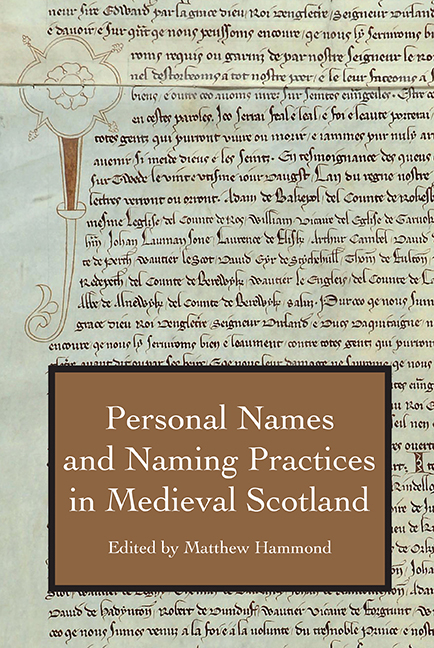Book contents
- Frontmatter
- Dedication
- Contents
- List of Tables
- Acknowledgements
- List of Contributors
- Abbreviations
- Note on the Text
- 1 Introduction: The Study of Personal Names in Medieval Scotland
- 2 Personal Names in Early Medieval Gaelic Chronicles
- 3 Gaelic Personal Names and Name Elements in Scottish Charters, 1093–1286
- 4 The Development of Mac Surnames in the Gaelic World
- 5 Forflissa/Forbflaith/Hvarflöð
- 6 Masculine Given Names of Germanic Origin in the Ragman Roll (1296)
- 7 The Romance of Names: Literary Personal Names in Twelfth- and Thirteenth-Century Scotland
- 8 Old Testament Personal Names in Scotland Before The Wars of Independence
- 9 Duthac Wigmore and Ninian Wallace: Scottish Saints and Personal Names in the later Middle Ages
- 10 Saints in Names in Late Medieval Argyll: a Preliminary Enquiry
- Bibliography
- Index
- Studies in Celtic History
9 - Duthac Wigmore and Ninian Wallace: Scottish Saints and Personal Names in the later Middle Ages
Published online by Cambridge University Press: 18 September 2019
- Frontmatter
- Dedication
- Contents
- List of Tables
- Acknowledgements
- List of Contributors
- Abbreviations
- Note on the Text
- 1 Introduction: The Study of Personal Names in Medieval Scotland
- 2 Personal Names in Early Medieval Gaelic Chronicles
- 3 Gaelic Personal Names and Name Elements in Scottish Charters, 1093–1286
- 4 The Development of Mac Surnames in the Gaelic World
- 5 Forflissa/Forbflaith/Hvarflöð
- 6 Masculine Given Names of Germanic Origin in the Ragman Roll (1296)
- 7 The Romance of Names: Literary Personal Names in Twelfth- and Thirteenth-Century Scotland
- 8 Old Testament Personal Names in Scotland Before The Wars of Independence
- 9 Duthac Wigmore and Ninian Wallace: Scottish Saints and Personal Names in the later Middle Ages
- 10 Saints in Names in Late Medieval Argyll: a Preliminary Enquiry
- Bibliography
- Index
- Studies in Celtic History
Summary
In the mid-fifteenth century an Edinburgh burgess with the rather unusual name of Duthac Wigmore first enters the historical record. Precisely why his parents chose this name will never be known for certain. It does seem to indicate veneration on their part, or within their social circle, however, for a northern Scottish saint whose shrine was located several hundred miles to the north in Easter Ross. The earliest recorded dedication in Edinburgh to St Duthac was an altar founded in his honour in the church of St Giles in 1438, when Wigmore was already an adult. The appearance of the name therefore indicates the presence of the cult in Edinburgh, and in southern Scotland, before this was confirmed by official records. Perhaps less surprising was the decision by another Edinburgh couple called Wallace to name one of their children Ninian in the late fifteenth century. Veneration of the saint of Whithorn was firmly established in Edinburgh by that period, with an altar dedicated to Ninian in the burgh church of St Giles in Edinburgh since 1439 and where he was one of the co-dedicatees of Trinity College (founded 1462). It is a relatively straightforward process to identify the major trends in devotion to the saints among the Scottish political, clerical, and urban elites in the later Middle Ages. The royal house, nobility, clergy, and wealthy merchants and craft organizations were responsible for the vast majority of recorded acts of veneration of the saints, through gifts to shrines, the foundation of chantries, or the marking of feast days in their books of hours and psalters. Identifying such trends among the rest of the late medieval Scottish population is considerably more complicated, often limited to vague references to crowds of pilgrims at Whithorn and Tain, or criticisms of popular devotional practice within literary works. Personal name evidence, such as the appearance of men called Duthac and Ninian in later medieval Edinburgh, provides one potential source for bridging this gap.
For the fifteenth and sixteenth centuries there is a major expansion in the range of surviving sources for exploring naming patterns in the kingdom of the Scots. According to a thesis put forward by David McRoberts in 1968, that period was also characterized by a self-consciously nationalist trend in Scottish religious practice.
- Type
- Chapter
- Information
- Publisher: Boydell & BrewerPrint publication year: 2019



